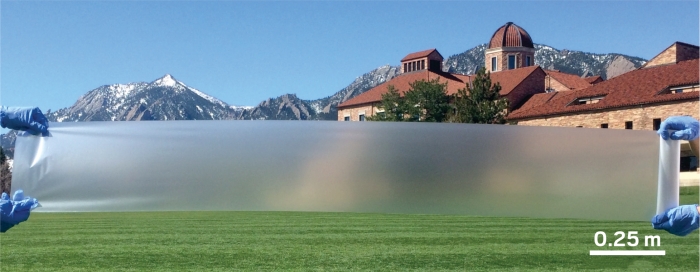Advertisement
Grab your lab coat. Let's get started
Welcome!
Welcome!
Create an account below to get 6 C&EN articles per month, receive newsletters and more - all free.
It seems this is your first time logging in online. Please enter the following information to continue.
As an ACS member you automatically get access to this site. All we need is few more details to create your reading experience.
Not you? Sign in with a different account.
Not you? Sign in with a different account.
ERROR 1
ERROR 1
ERROR 2
ERROR 2
ERROR 2
ERROR 2
ERROR 2
Password and Confirm password must match.
If you have an ACS member number, please enter it here so we can link this account to your membership. (optional)
ERROR 2
ACS values your privacy. By submitting your information, you are gaining access to C&EN and subscribing to our weekly newsletter. We use the information you provide to make your reading experience better, and we will never sell your data to third party members.
Water
Superefficient solar desalination
System harnesses waste heat to produce enough drinkable water for an adult in one hour
by Prachi Patel
February 13, 2020

Portable devices that use sunlight to remove salts from seawater could provide affordable drinking water to people in remote or arid coastal areas. But solar-powered desalination technologies have suffered from low efficiencies. Researchers have designed an ultraefficient prototype that makes 72 mL of desalinated water in an afternoon and, in ideal lab conditions, makes almost three times as much as previous similar devices (Energy Environ. Sci. 2020, DOI: 10.1039/C9EE04122B).
Conventional desalination plants, which rely on membranes, are expensive or use a lot of energy. Solar thermal desalination is a less expensive option but is inefficient and requires immense parabolic mirrors to focus light on seawater to evaporate it. Neither technology is suited for remote or resource-poor areas. Portable solar-powered desalination devices address this problem. These typically use less expensive sunlight-absorbing materials that heat and evaporate seawater. The vapors are collected on a condenser, which gathers fresh water. The best systems can convert over 90% of the sun’s energy to generate water vapor.
Now Evelyn Wang of MIT, Ruzhu Wang of Shanghai Jiao Tong University, and their colleagues made a multistage system that goes way beyond this, boasting an efficiency of 385% when tested under ideal conditions. It does that by reusing the heat that is released when water vapor condenses to liquid. It’s the first system to take advantage of this energy, which is usually wasted.
The device contains 10 identical 3-D printed nylon frames stacked and placed vertically on top of a water reservoir. Each frame has a paper towel that acts as the evaporator and an aluminum film that serves as the condenser. On the sun-facing side of the stack, the researchers place a black solar absorber that heats up and evaporates the water that wicks up into the paper towel. As vapors condense on the aluminum film, the heat released gets channeled to the second paper towel layer, with the process repeating down the stack. Such a multi-stage approach has been used in large-scale solar thermal desalination plants, says Wang’s graduate student Lenan Zhang. “We transferred this idea into a portable design.”
Using laboratory test results of the 10 cm × 10 cm device, the researchers calculated that a 1 m2 device would produce 5.8 L of water per hour. In less than ideal conditions, on an MIT rooftop in summer, the device’s performance was lower, about 50% because of occasional clouds and wind. On the roof, the device produced 72 mL of water in 4.5 hours. To meet the average daily water needs for an adult or a small family, you could create an array of the multistage devices, Zhang says.
The team now wants to optimize the device and to further reduce material cost. The prototype now costs around $1.50, but 70% of that cost is the 3-D printed nylon frames, Zhang says, so there’s room for improvement.
This a highly efficient and cost-effective approach for solar desalination, says Hadi Ghasemi, a mechanical engineer at the University of Houston. “This work brings the concept of solar heat localization a step closer to large scale implementation.” Using different wicking materials that have antifouling characteristics will help for long-term consistent performance of this device, he says.
CORRECTIONS:
This story was updated on Nov. 21, 2022, to correct the size of the solar desalination system for the given water output rate. A 1 m2 device, not a 10 cm × 10 cm device, could produce water at a rate of 5.8 L per hour.
This story was updated on Feb. 20, 2020, to correct the efficiency of the multistage solar desalination system. The system's efficiency is 385%, not 358%.





Join the conversation
Contact the reporter
Submit a Letter to the Editor for publication
Engage with us on Twitter